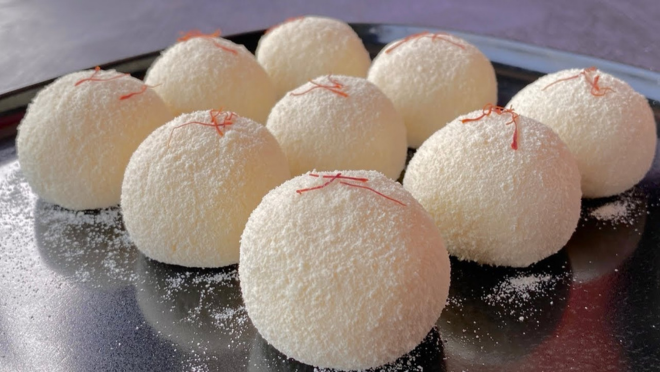Natore’s kachagolla: A timeless traditional sweet of Bangladesh
Natore’s kachagolla: A timeless traditional sweet of Bangladesh

Bangladesh is famous for its wide variety of traditional sweets, each carrying a distinct taste and cultural identity. Among them, Natore’s Kachagolla holds a special place. This sweet, made from raw chhana (cottage cheese), originated in Natore District and has become a symbol of heritage and pride for the region. In recognition of its uniqueness, Natore’s kachagolla was declared the 17th Geographical Indication (GI) product of Bangladesh on 8 August 2023.
The origin story
The history of Kachagolla is tied to an interesting story of chance and necessity. In the town of Natore, Madhusudan Pal owned a famous sweet shop in Lalbazar. His shop was known for producing a large quantity of sweets such as Pantua, Chamcham, and Kalojam, with several workers assisting him.
One day, when his skilled sweet maker was absent, Madhusudan found himself in a dilemma with a huge amount of chhana left unused. To prevent wastage, he instructed his workers to mix sugar syrup with the chhana and heat it slightly. To everyone’s surprise, the result was a new sweet with a delightful taste and aroma.
Since the chhana was used raw, unlike Rasgolla where it is fried before soaking in syrup, the new sweet was named Kachagolla. Over time, this sweet gained popularity among local people, and Madhusudan continued to produce it regularly.
In 1760, during the reign of Rani Bhabani, the benevolent ruler of half of Bengal, the fame of Kachagolla spread across the country and abroad. Alongside it, sweets such as Abak Sandesh, Raghobshahi, Chamcham, Rajbhog, Rosomalai, and Panitoa were also popular. Yet, among them all, Kachagolla rose to the top, becoming the favored delicacy for the zamindars’ feasts. Remarkably, it was even sent to the royal family in Britain.
The Rajshahi Gazette mentioned its reputation, and newspapers in Kolkata also published articles highlighting the fame of Kachagolla.
Kachagolla is distinct from other sweets due to its preparation method and natural flavour. It retains the raw aroma of chhana, which cannot be found in other traditional sweets. Its soft, grainy texture and mild sweetness make it stand out from common milk-based desserts in Bangladesh.
How to make kachagolla
The preparation of Kachagolla involves two main steps:
Step 1: Making chhana
Milk is mixed with water and boiled in a large pan. Vinegar is added gradually to curdle the milk, separating the whey from the curd. The curd is strained, tied in a cloth, and hung overnight to remove excess water. Finally, the chhana is kneaded until smooth and fine.
Step 2: Making kachagolla
The chhana is divided into three parts. Two parts are heated with sugar until the mixture becomes sticky. The remaining part of chhana is added along with cream and cardamom powder. After cooking gently, the mixture is strained and cooled. The final product is broken into grainy pieces and sold as kachagolla.
Beyond being a delicious dessert, kachagolla is a symbol of Natore’s cultural heritage. Its recognition as a GI product not only preserves its authenticity but also boosts local economic opportunities by increasing demand both within Bangladesh and abroad.


